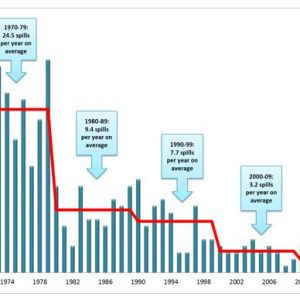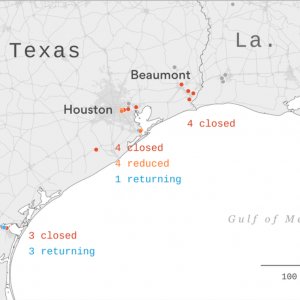News is just breaking that the repair of the embattled trunk line delivering crude oil from Refugio’s onshore distribution facility to refineries in Kern County that ruptured last May and caused the Refugio Oil Spill may take a long, long time to repair.
While I have found such estimates to almost assuredly be overblown, the sheer order of magnitude (years) is quite noteworthy here and speaks to aging infrastructure that may not have been as well maintained as we would all like to think. The infrastructure crisis in the U.S. in not just a government issue: the private sector can be similarly cheap. We last, most dramatically, saw this with BP’s “run to failure” policy in Alaska and across various other global oil production units.

An aerial photo of the section of pipeline that ruptured on May 19, 2015 and ultimately sent crude oil into the ocean at Refugio State Beach. Federal investigators found extensive corrosion in that section of pipe. Image: John Wiley.
From the Pacific Coast Business Times:
excerpted from Alex Kacik’s November 5th 2015 piece Refugio oil spill pipeline might take five years to get back online
The pipeline that was responsible for the Refugio oil spill in May could take up to five years to get back online and the best-case scenario is 18 to 24 months, according to California Economic Forecast Director Mark Schniepp.
He spoke to a room full of the biggest oil players in Santa Barbara County, public officials and members of the Chumash on Nov. 5 about Santa Maria and the region’s economic future, which are inextricably tied to the oil and gas industry.
If Houston-based Plains All American Pipeline’s Line 901 remains dormant over the next three years, Santa Barbara County could lose out on an estimated $74 million, Schniepp told about 100 people at the Economic Action Summit at the Radisson in Santa Maria.
The county would potentially miss out on about $5 million in federal royalties, $37 million In property taxes, 155 jobs and $32 million in worker income.
“This could probably be expedited and, given the economic impacts I’m about to show you, it ought to be expedited,” Schniepp said about making Line 901 operational. “There are a lot of claimants losing a lot of dollars and will lose them going forward.”
…Exxon is the region’s biggest oil operator, producing nearly 30,000 barrels per day that generated nearly $1.2 billion in revenue last year. Exxon was on pace to make an estimated $636 million in Santa Barbara County in 2015, Schniepp said, but it has only generated an estimated $216.6 million because production was shut down after the May oil spill. About 65 jobs may be transferred to other Exxon facilities, he said
Santa Barbara County recently rejected Exxon’s emergency application to truck oil to refineries because the company did not prove that an emergency exists, the county said.
“It seems that we should probably do what we can do to get things up and running in order to enjoy the benefits we had prior to the shut down,” Schniepp said. “People are going to feel it.”
…Since the oil spill, public officials have called for more vigilant pipeline regulation, requiring the use of new technology and improving oil spill response. Gov. Jerry Brown signed three bills that require the California Fire Marshall to review oil pipeline conditions every year, not every five years as mandated by more lax federal regulations; aim to make oil spill response faster and more effective; and force intrastate pipelines to use the best-known technology such as automatic shutoff valves. Line 901 is an interstate pipeline.





Leave a Reply